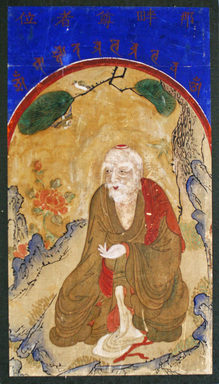
Medium: Ink and colors on cloth, now framed
Geograhical Locations:
Dates:1884
Dimensions: 20 3/8 × 12 1/2 in. (51.7 × 31.7 cm)
Collections:
Accession Number: 2020.18.8
Image: CUR.2020.18.8_overall.jpg,
Catalogue Description: Painting of Dok-seong, a Daoist deity who was absorbed into Korean Shamanist and Buddhist practices. The "lonely saint" or "hermit saint" sits in a mountain setting with emblems of longevity and good luck around him (pine tree, pair of birds, peony, bamboo, rocks). The image has an arched top and in the space above, on a bright blue ground, are inscriptions in Chinese and Sanskrit script, written in red paint. These inscriptions identify the subject as Pindola Bharadvaja (Korean: Na-ban Jeon-ja Ui), the celebrated Buddhist Arhat, an original disciple of the Buddha Shakyamuni. Dok-seong is often identified with Pindola in Korean Buddhist tradition. His name means "sel-cultivation" and he represents spiritual perfection and longevity. Although similar in guise and function to San-Shin, another elderly Korean mountain spirit, Dok-seong is typically not depicted with a tiger or attendants. On the reverse is a page with lengthy inscriptions in Chinese characters in black ink, and Sanskritic mantras or seed syllables in red ink. The object is dated, to the 10th year of Guang-xa, or 1884. That date appears in he inscriptions on the reverse, along with indication that the painting was once in the possession of Haeinsa, one of the most important Buddhist temples in Korea.